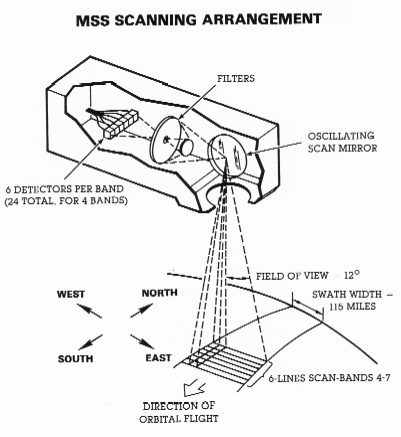More info:
- An image from the original digital camera on the prototype digital playback system, accodirg to NYTimes.
- Stephen Sasson of Eastman Kodak Invents the Digital Camera : History of Information
- Wikipedia: Steven Sasson - First self-contained digital camera
- Kodak’s First Digital Moment (Lens blog - NYTimes - WebArchive)
It’s worth noting this is the first commercially available digital camera. The digital camera aboard Landsat 1 (launched 1972) was developed in 1969, predating this by 6 years.
EDIT: I looked at the wrong instrument. See comments below to read about the MSS, “the oldest operational multispectral digital sensor”
This is what I see from a quick search. According to Wikipedia page Landsat 1 - Sensors:
ERTS-A had two sensors to achieve its primary objectives: the return beam vidicon (RBV) and the multispectral scanner (MSS).
And from Return-Beam Vidicon (RBV) Overview:
The Return-Beam Vidicon (RBV) sensor utilised vidicon tube instruments containing an electron gun that read images from a photoconductive faceplate similar to television cameras. The data stream received from the satellite was analog-to-digital preprocessed to correct for radiometric and geometric errors.
So… if I understand it correctly, it was an analog camera which signal was at the end converted to digital. But please correct me if I’m wrong!
ninja-EDIT: What happened on 1969, according to The First Digital Camera Was the Size of a Toaster - IEEE Spectrum:
CCDs […] were invented in 1969 by Willard Boyle and George E. Smith at Bell Labs,
This also may be my lack of understanding, but I was referring to the Multi Spectral Scanner (MSS) on Landsat 1 which used band scanning and stored/transmitted digital images. https://gisrsstudy.com/multispectral-scanner-sensor/
Ok, I looked at the wrong instrument.
Regarding the MMS, here (page 3) it says:
MSS sensor, the oldest operational multispectral digital sensor
Then I found this diagram (with some explanations on this link):

If I understand correctly, that means it has a 6 pixel-row resolution that it uses to scan a 2D area.
Finally, I realized I was using a wrong idea of “digital camera”. There is no true “digital sensor”, all sensors are analog and always need a postprocess to convert to digital… right?
As always, it’s impossible to provide a non-ambiguous definition. Is a 6-pixel row res instrument on a satelite a “digital camera”? … kind of :)
Anyway, fascinating topic. Thanks for the input!
I remember reading about how Kodak tried to block digital cameras (even its own) so as not to compromise their own film business, only to be caught unprepared later on when the digital camera revolution came anyway and then took massive losses.
It’s funny how they build the first.
I read an interesting analysis: We as consumers just see pictures, but to them they were a chemical processing company. That didn’t translate at all to digital pictures in any way like corporate experience, mindset, technical expertise, etc. It would have been hard to mentally make the change before it hit them in the face.
